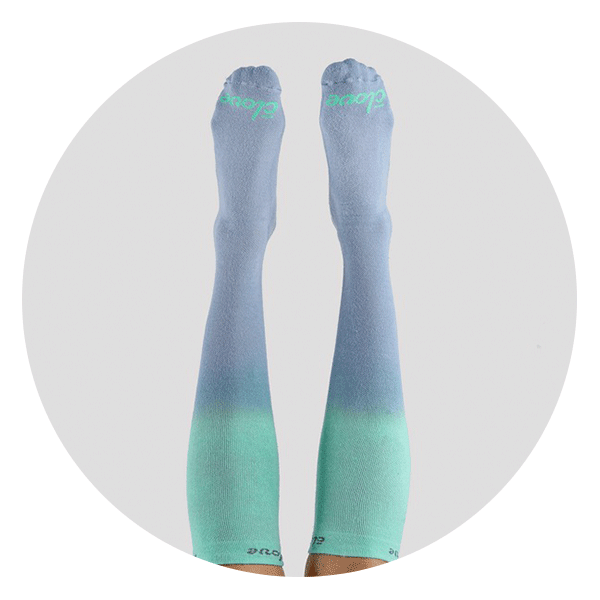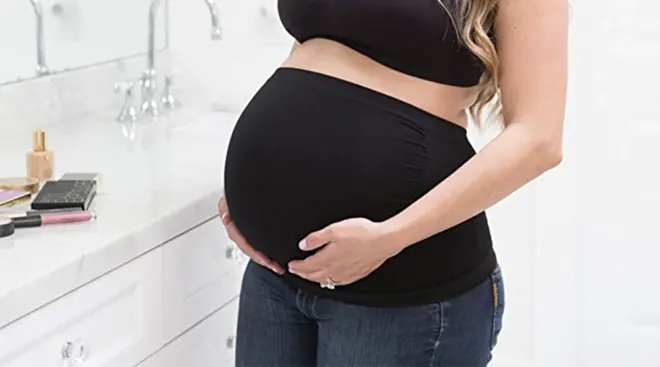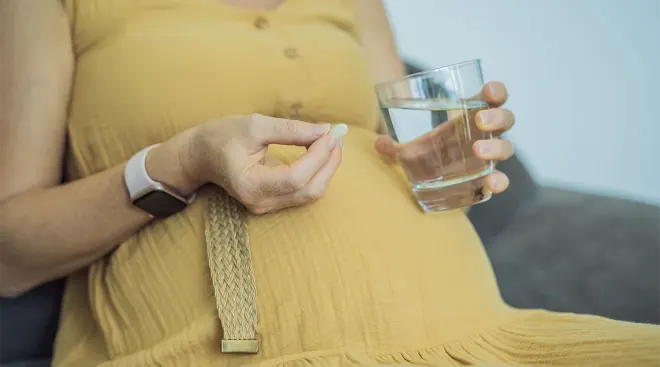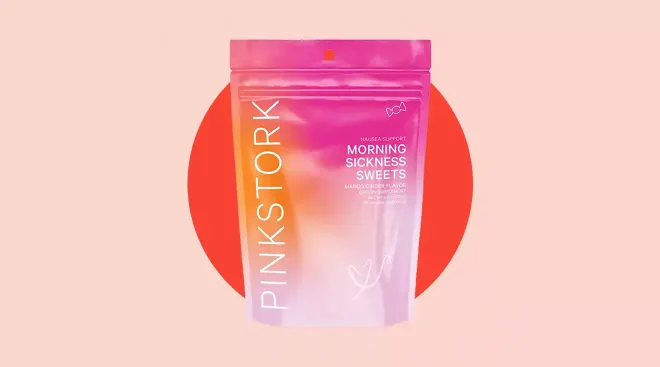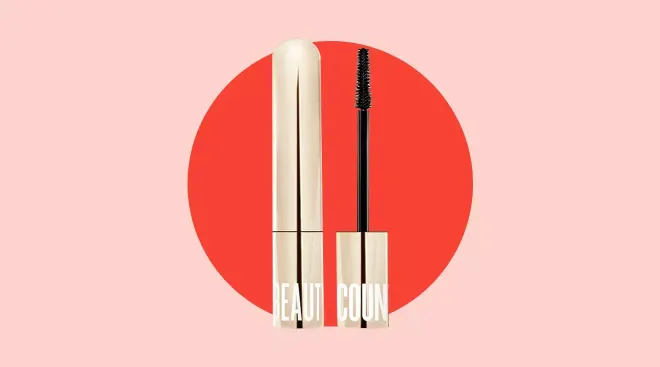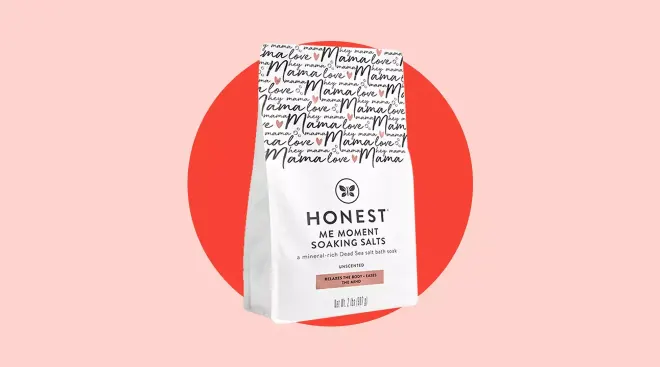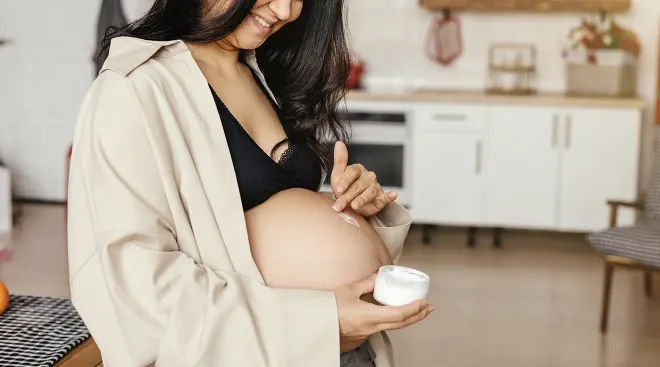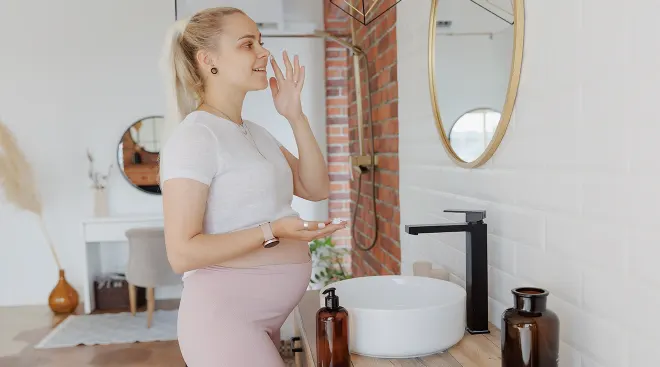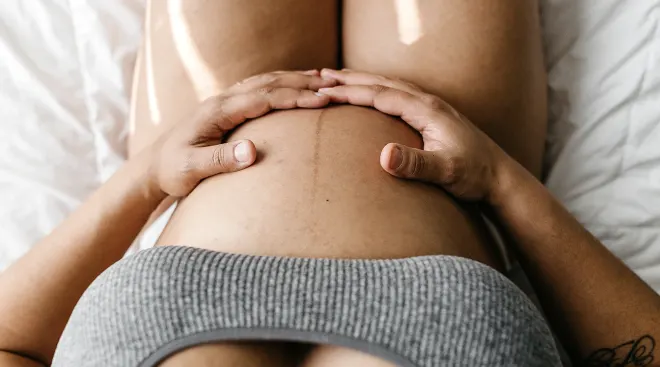The 6 Best Compression Socks for Pregnancy, Tested by an Expectant Mom
In a nutshell:
Based on advice from three medical professionals, a survey of over 350 expectant parents from The Bump community, and the author’s hands-on product testing, we chose Comrad Compression Socks as the overall best compression socks for pregnancy. This pair stood out because they were easy to put on, alleviated pregnancy-related foot pain and swelling and were comfortable enough for all-day wear.
If you’re pregnant, you’ve probably been told to “relax and put your feet up” on countless occasions. After all, your body is being put through the wringer, so if anyone deserves to put their feet up, it’s you! But if you’re finding it hard to rest, recover and reduce the swelling that commonly plagues the legs and ankles of moms-to-be, opt for a pair of pregnancy compression socks.
Compression socks are an inexpensive, easy way to avoid or reduce swelling, blood clots and venous disorders—all of which occur at higher risk during pregnancy. They accomplish this by “gently squeezing the limbs to help circulate blood throughout the body,” says Loren Ball, WHNP, a nurse practitioner in women’s health for Hoboken University Medical Center.
Want to find the best compression socks for pregnancy that will deliver targeted relief throughout your day-to-day? I’ll give you the lowdown. I’m currently in my third trimester with my first baby and dealing with foot, ankle and hand swelling, and I’ve personally tried the top-rated compression socks on the market. Below, shop our top picks and find expert-backed answers to your frequently asked questions about compression socks for pregnancy.
To help you find the best maternity compression socks, The Bump editors browsed dozens of options on the market and created a list of 19 products. After carefully considering each, we narrowed it down to a short list of eight options—then, we put them to the test. Here’s how we created this roundup:
- I personally tested eight different compression socks during weeks 33 to 35 of my pregnancy. I wore all eight pairs and rated them on features like fit, compression level and comfort, to name a few.
- We interviewed a nurse practitioner, a nurse midwife and a family medicine physician to better understand the essential features to consider when shopping for pregnancy compression socks.
- We surveyed over 350 new and expectant parents in The Bump community for additional insight on the ins and outs of specific compression socks for pregnancy.
- We researched what was being said about compression socks in The Bump community forums to learn what parents liked and disliked about certain products.
- To understand how these top-rated compression socks have worked for a variety of pregnant women, we conducted exhaustive market research, scouring external forums and message boards and reading user reviews to discover what parents nationwide looked for in maternity compression socks.
- We considered several factors when sourcing compression socks for pregnancy, such as material, fit, size range and more.
Editorial integrity is at the heart of everything we publish. Read about how The Bump develops and reviews all articles, including product reviews.
Overall best compression socks for pregnancy
- Moisture-wicking material prevents overheating
- Seamless toes stop blistering
- Perfect for all-day wear
- Wide-width options
- Tricky to get on and off
- Some women say they’re too long
Once I got these pregnancy support socks on, I barely noticed them—and I mean that in the best possible way. Comrad’s Compression Socks are made with a comfortable 15-20 mmHG of compression, making them a great option for whatever you have on your to-do list. The fabric was even slimmer than my normal socks—a nice touch that made it easier to slide my feet into my shoes. I put these on as soon as I finished my morning workout and they drastically cut down on the usual post-exercise foot pain that has gotten exponentially worse since hitting the 30-week mark.
These maternity compression socks also worked wonders when I wasn’t exercising. I wore them around the house all day while doing my usual chores. The material was light, comfy and resulted in zero itchiness around my calves. Plus, if you’re like me and have been napping at least once a day during your third trimester, these are ideal. I usually loathe wearing socks in bed, but the moisture-wicking fabric prevented my feet from getting sweaty or overheated, even when tucked under the covers. 48 percent of our survey respondents told us they looked for pregnancy compression socks that were breathable—and this pair definitely checks that box.
While the pair I tested were pink-and-white ombré, Comrad offers various colors and patterns, so you’re sure to find an option that aligns with your personal style. The final verdict: These pregnancy compression socks were my favorite that I tried. I would definitely recommend them to anyone experiencing severe swelling.
Size range: S to XL | Compression level: 15-20 mmHg | Material: 91% nylon/9% spandex | Care instructions: Machine wash cold, hang dry
Our product tester says: “The fabric was light and breathable so I could comfortably wear them all day without feeling like my feet were getting hot and stuffy.”
Our community says:
"I ordered three pairs of Comrad compression socks— which feel really good and are kind of cute, too—in order to combat any foot/ankle edema." – laurenmicheley, The Bump forum member
"I bought a pair of Comrad socks, wore them all day around a conference, and then on a five-hour flight and found them really comfortable!" – newmama46, The Bump forum member
"I liked the colors and widths that Comrad offered. Having larger calves, finding the right compression and size was important. Comrad had plenty of options." – Brittany, The Bump survey respondent and an expectant mom
Best easy-on easy-off compression socks for pregnancy
- Snug fit without pain, pinching or itching
- Significant pain and swelling reduction
- Easy to slide on and off
- Wide-width options
- Fabric can cause skin indentations
As I write this article, I’m far into my third trimester, and I’ve reached the point where bending over leaves me out of breath and seeing stars. The last thing I need is to struggle with putting on a pair of socks. Of the pregnancy compression socks I tested, the Quince Recycled Maternity Socks were by far the easiest to get on, which was an immediate point in their favor. It’s no secret that pregnancy compression socks, much like tights and pantyhose, always require some extra effort—but in comparison to some of the socks I tested, these were a breeze. They slid on and off relatively easily without being so loose as to sacrifice benefits like a reduction in pain and swelling.
I put on a pair of Quince socks right after hitting the gym when my feet were at peak pain and swelling and felt instant relief that lasted all day. I also wore them to check the mail and do some outside chores and could slip my shoes right on and off. The material is airy and breathable, making these the ideal easy-on, easy-off socks for day-to-day wear. They’re also light enough that you could easily wear these under your pants, or even tights, without anyone noticing. Better yet, these circulation socks for pregnancy look just like a regular pair and would blend in with any outfit. I genuinely enjoyed wearing these and, and had to remind myself not to sleep in them because I didn't want to take them off!
Size range: S to LW | Compression level: 15-30 mmHG | Material: 68% recycled nylon/12% nylon/15% polyester/5% spandex | Care instructions: Machine wash cold, tumble dry low
Our product tester says: “The material was light and they kept my feet snug and compressed without causing any pain or pinching. I would absolutely wear these again.”
Our community says:
"These are comfortable, long and soft." – Rima*, The Bump survey respondent and an expectant mom of one
Best everyday compression socks for pregnancy
- Honeycomb arch support
- Looser fit ideal for everyday wear
- Seamless toes to prevent blisters
- Not as effective in reducing swelling
- Thicker than other options
Out of all the circulation socks for pregnancy that I tried, Bombas felt most like an everyday pair of socks. They’re snug enough to alleviate some pain and swelling but stretchy enough to avoid issues like itching and pinching. Compared to other socks I tested, the Bombas Everyday Compression Socks have a thicker fabric. While the bulk made it a little bit more challenging to put on shoes, the material was easy to put on my feet, and nice and stretchy, so the socks didn't make my calves itch as much as other options. Lyla*, an expectant mom who responded to our survey, described these socks as “comfortable, and [offering] enough compression without being too tight.” That kind of comfort is important when you’re looking for something the perfect set of day-to-day socks.
Moreover, the thick cotton blend was much appreciated as I wore them when working in my chilly basement. This is a great brand for a low-key day when you’re just lounging around and not on your feet often. Plus, they’d be a great option for cooler months when your feet need extra warmth. All in all, these were comfortable but a little closer to a regular sock. They’d be a good option if your symptoms are more mild.
Size range: S to L | Compression level: 15-20mmHg | Material: 68% cotton/17% polyester/9% spandex/6% nylon | Care instructions: Machine wash cold, tumble dry low
Our product tester says: “They were nice and stretchy so they didn't make my calves itch as much as some of the other options I tried. They were also super cozy.
Our community says:
"These socks were soft and comfortable with the correct level of compression." – Eliza, The Bump survey respondent and an expectant mom
"These compression socks are definitely helpful during pregnancy, especially when traveling. I found them very beneficial when flying 8 hours. [They] helped with the swelling in my feet due to lack of movement and altitude." – Stephanie, The Bump survey respondent and an expectant mom of one
Best pregnancy compression socks for exercise
- High compression level alleviates foot pain
- Significant reduction in swelling during and after use
- Soft, cushioned bottoms
- Difficult to get on and off
- Can cause some pinching, especially near the toes
With a compression level of 20-30 mmHG, Clove Compression Socks are tight, so some may not find them ideal for all-day wear. However, I thought they worked especially well for exercise. Foot pain makes it notoriously tough to stay active during that last leg of pregnancy, and out of all the socks I tested, Clove helped the most with alleviating workout-related aches. On the day I tested them, I wore them seated for a long time as I worked and then I walked around quite a bit, cooking dinner afterward. While wearing them, I barely noticed they were on.
A week after testing them initially, I tried these pregnancy support socks again at the gym, and my workout was significantly easier on my feet. Fair warning: These are tough to get on and off, but they’re worth it for the extra compression. The breathable material prevented my feet from getting hot and stuffy, even after a nap under the covers. You’ll also appreciate that the fabric is thin enough that you can wear them under jeans, tights or leggings. Better yet, Clove offers circulation socks for pregnancy in plenty of adorable designs. The pair I tested were in the “Ocean Fade” colorway, a cute ombré pattern going from green to blue, which I loved.
Size range: S to L | Compression level: 20-30 mmHG | Material: Cotton/elastic/spandex/polyester | Care instructions: Machine wash cold, tumble dry
Our product tester says: “My shoes were definitely much easier to get on while wearing these socks, and walking around—even after a pretty intense workout—was much less painful with these socks on.”
Our community says:
"These compression stockings help keep swelling out of my lower legs and feet." – Ellen, The Bump survey respondent and an expectant mom of two
Best pregnancy compression socks for travel
- Moisture-wicking and odor-reducing fabric
- Significantly reduced foot pain and swelling
- Easily fit underneath clothes
- Wide-width options
- Can cause itchiness after you take them off
- Limited sizing
When traveling, you’re often on your feet more than usual or sitting for long periods on flights or in the car, which can be especially tiring when pregnant. Luckily, this pair of maternity compression socks can be counted on to ease aches and pains while you’re on the go. I was on my feet a lot the day I wore these socks—including going out to dinner with friends—and I barely noticed they were there. They did a great job of reducing swelling and pain while I was out and about, and, as I was heading out the door, they made it much easier to slip my shoes on. Despite having a high compression level of 20-30 mmHG, I found the Kindred Bravely Premium Maternity Socks to be incredibly comfortable, while also effective.
The fabric of these pregnancy support socks also stood out during testing. They were thin enough to easily slip them under pants or tights, so they weren’t super noticeable. They weren't excessively bulky or itchy and were easy to pull off at the end of the day. Plus, the breathable material caused zero issues with sweat or overheating. According to our survey, 51 percent of pregnant women looked for maternity compression socks that were travel-friendly. If you count yourself among this majority, these will definitely be a top-notch choice.
Size range: Regular calf to Wide calf | Compression level: 20-30 mmHG | Material: 60% bamboo viscose/15% spandex/23% spandex/2% nylon | Care instructions: Machine wash cold, tumble dry low
Our product tester says: “These reduced foot swelling and made it much easier to slip my shoes on. The fabric wasn't too thick or hot so it didn't add any additional discomfort while successfully reducing pregnancy-related foot pain.”
Our community says:
"I like how they feel once they are on. I believe they make a difference with cramps and restless leg syndrome." – Julie, The Bump survey respondent and an expectant mom
Most subtle compression socks for pregnancy
- Moisture-wicking fabric to prevent overheating
- Everyday look and feel
- Significant reduction in pain and swelling
- Itchy, according to some reviewers
- Run small
Despite having a compression level of 20-30mmHG, PRO Compression Marathon Socks feel more or less like regular socks once they’re on. That said, their subtlety does not mean they fail to get the job done—but quite the opposite. Even though I didn’t notice any extra tightness when wearing them, these pregnancy compression socks somehow managed to reduce my foot pain and swelling significantly, especially during the first few hours of wearing them. Best of all, they made it much easier to get my increasingly swollen feet in and out of my shoes!
A lot of compression socks for pregnancy come in fun colors and patterns, but I appreciated that the pair I tested was plain black. Out of all the options I've tried, these looked the most like regular day-to-day socks; I liked that the style just blended in. If you’re looking for high-quality compression socks that won’t squeeze the life out of your feet but will still deliver relief, PRO is the way to go.
Size range: XS to L/XL | Compression level: 20-30mmHG | Material: Nylon/spandex | Care instructions: Machine or hand wash cold, line dry
Our product tester says: “These socks reduced a significant amount of swelling and pain while I was wearing them and were easy to take off.”
Our community says:
"PRO Compression! I wore them running pre-pregnancy, and now they will be my [pregnancy] socks, too!" – 26pointrunningfor2, The Bump forum member
"There are plenty of options out there, but PRO Compression is my favorite! A little pricy but worth it." – knottie9e29b57c17ae0542, The Bump forum member
*Note: Some names have been changed due to privacy requests.
No one said growing a new human was easy. Pregnancy can come with a slew of uncomfortable symptoms and conditions, but the gentle pressure of compression socks can help with many of them! Below, find out how they can help.
Reduce swelling and the chance of blood clots
During pregnancy, your body produces about 50 percent more blood and fluids to support baby’s development—and while those fluids usually disperse proportionately, they can pool in certain areas like the legs, feet, ankles and fingers, leading to uncomfortable swelling. Moreover, your expanding uterus can put pressure on your veins and constrict blood flow to your heart, limiting circulation and increasing swelling.
This decreased circulation, as well as a natural spike in estrogen, also increases the odds of developing a blood clot. “In pregnancy, women are five times more likely to develop or experience a blood clot compared with women who are not pregnant,” Bell says. Deep vein thrombosis (DVT) are blood clots that commonly occur in the deep veins of your lower extremities, according to Ankita Sahni, MD, a family medicine doctor at Texas Tech University Health Sciences Center El Paso. In the event that a DVT is not mediated, it can break off and travel to the lung, causing a blockage in its tissue. What can come next is a pulmonary embolism (PE), a potentially life-threatening issue.
The good news? Snugly fitted compression socks, which usually extend to just below the knee and provide gradient pressure along the length of the calf, effectively reduce swelling and the risk of blood clots, as they “aid in circulation and blood flow,” says Kristin Mallon, CNM, MS, RNC-OB, a board-certified nurse midwife for Integrative Obstetrics in Jersey City. What’s more, she adds, “since leg cramps are associated with poor circulation, compression socks can also aid in alleviating leg cramps in some patients.”
Ease varicose vein pain
Varicose veins can also develop as your pregnancy progresses, which can bring about pain, aching, itchiness and burning sensations that are incredibly irritating and relentless. Compression socks can help by moving blood away from the legs and up toward the heart. “If a patient has varicose veins, compression socks can be great in preventing them from getting worse, and decreasing the discomfort associated with varicose veins,” says Mallon.
While compression socks can offer a bunch of benefits during pregnancy, experts warn against using compression stockings. For one, they place constriction on your belly, especially as you transition from the second to third trimester; plus, compression pantyhose worn for more than eight hours over several days can “increase the risks for yeast and bacterial vaginosis,” Mallon says, which are already common in pregnancy when hormones are surging. If you need to dress up a bit more for work or events, consider a pair of maternity leggings with compression support, but take them off as soon as you get home to give your body a break.
So when should you start to slip on those compression socks in pregnancy? Well, whenever swelling becomes more prominent. “Usually during the second and third trimester, women will start to notice spider veins and swelling, which can be uncomfortable,” says Ball. Also, if you’ve been confined to bed rest, immobile for more than four days or have been diagnosed with hyperemesis gravidarum, Sahni recommends wearing compression socks.
Whether your job requires you to be on your feet or even stationary for the majority of the day, using compression socks is a great way to reduce swelling or improve circulation. They’re also good if you’re planning to travel while pregnant. Along with advising her patients to move around, stand and flex their ankles and feet on flights, Ball says “it’s extremely important to wear compression socks, because of the significantly higher risks of blood clots due to limited activity.”
All three experts we spoke with say that compression socks work best when you put them on first thing in the morning, even before getting out of bed. At that point, swelling is minimal, because the body has been lying flat throughout the night, so it’s much easier to put the socks on. “Many women put them on toward the end of the day when they realize that there is swelling in their legs, but if they are worn in the morning, this can prevent the swelling instead of treating it,” Ball recommends. Compression socks are more efficient when they’re used proactively versus reactively.
We couldn’t name the best compression socks for pregnancy without addressing compression itself. There’s no one-size-fits-all solution here and there are many different levels of compression, ranging from low to high. The intensity of compression is measured in mmHg (which stands for millimeters of mercury), and as the number goes up, so does the pressure.
The right compression level for you depends on what issues you’re looking to treat. Sahni defines compression from light to firm, with the following therapeutic benefits for pregnancy:
- Light compression: 8-15 mmHg. Helps improve circulation and provides relief to fatigued legs.
- Moderate compression: 15-20 mmHg and 20-30 mmHg. Helps improve circulation, prevent DVT and decrease swelling.
- Firm compression: Above 30 mmHg. Helps improve circulation, prevent DVT and decrease moderate to severe swelling.
Moderate compression in the range of 20-30 mmHg is typically what Sahni suggests for her pregnant patients: “This level of compression is comfortable and effective at preventing DVTs.”
She goes on to say that firm compression is certainly an option for moms-to-be with more advanced swelling, pain or discomfort, but will often require a prescription. Prescription socks that can be found in pharmacies or medical supply stores offer the greatest levels of compression and circulation assistance and can go all the way up the leg (hello thigh-highs!).
Sahni’s best advice? “Look for socks that say ‘gradual compression’ and have the compression gradient listed on the packaging.” Just like the name suggests, graduated compression means that the pressure will be proportionate to where it’s needed the most: tightest at the ankles or the bottom of the sock and loosest at the knee or top of the sock.
Frequently Asked Questions
What size compression socks should I wear?
Fitting compression socks can be challenging because your calf size matters as much as your shoe size. When looking at sizing guides, come prepared with your regular shoe size and calf measurements (the circumference of your calves, in inches). Knowing these two numbers will help you navigate the brand’s sizing scale, which usually goes from small to large or extra small to extra large if the brand has extended sizing.
Finding compression socks for pregnancy that fit your feet and calves is critical to getting that snug and supportive feel. When you receive your socks, you’ll know they fit correctly when your toes line up with the toe cap and your heels fit into the heel cup. Once you put them on, smooth the fabric around your leg to eliminate bunching or sagging and ensure a secure but never stifling fit. Sanhi recommends socks that extend to just below the knee, noting that they shouldn’t “cover up the back of the knees, as this could cut off circulation.”
Can I wear compression socks all day?
Even though pregnancy compression socks can be worn all day—provided they’re comfortable and don’t cause any numbness or skin breakdown (which happens when the pressure is too great and blood flow to the skin is temporarily cut off)—Mallon encourages her patients to slide the socks off when they go to bed at night. “Usually after 12 hours, it’s good to take them off,” she says. “I don't recommend wearing them more than that.”
About the writer:
Erin Wisti is a writer and journalist living in Los Angeles. She is a regular contributor to the hyperlocal newsroom Knock.LA and her essays have appeared in publications including Fourth Genre, Electric Literature, Vice, Slate, NPR and more. She’s written on everything from baby clothes and pediatric safe sleep practices to cloud computing, and became well-versed in pregnancy products when she became pregnant with her first child, expected in June of 2024.
Interested in becoming a product tester for The Bump? Head here to apply.
Please note: The Bump and the materials and information it contains are not intended to, and do not constitute, medical or other health advice or diagnosis and should not be used as such. You should always consult with a qualified physician or health professional about your specific circumstances.
Plus, more from The Bump:
Loren Ball, WHNP, is a women’s health nurse practitioner working in Labor and Delivery at Hoboken University Medical Center. She graduated from Boston College in 2016 and worked as a registered nurse in labor and delivery for three years. She then earned her master’s from the University of Pennsylvania in 2019 and has been practicing inpatient and outpatient as a nurse practitioner for three years.
Kristin Mallon, CNM, MS, RNC-OB, is a board-certified nurse midwife, breast health expert, published author and a mom of four. She works in private practice in New Jersey and focuses on pregnancy, childbirth and the postpartum year.
Ankita Sahni, MD, is a family medicine physician with a vested interest in nutrition and integrative medicine. She’s currently training at Texas Tech University Health Sciences Center under the Department of Family and Community Medicine in El Paso, Texas.
Learn how we keep our content accurate and up-to-date by reading our medical review and editorial process.
Navigate forward to interact with the calendar and select a date. Press the question mark key to get the keyboard shortcuts for changing dates.





































